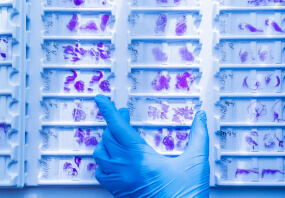General description
Polysialic acid (PSA) is a long, linear homopolymer that is attached to the neural cell adhesion molecule (NCAM). It has the remarkable ability to down-regulate a wide variety of contact-dependent cell interactions. This activity is believed to stem from the ability of the charged polymer to occupy a large hydrated volume and thereby cause a direct physical hindrance of cell–cell contact. The regulated expression of PSA has been shown to promote a reduction in cell interactions that can create permissive conditions for changes in the structure of a variety of tissues.
The broadest expression of PSA occurs on precursor cells during early development and plays a role in promotion of the migration of these cells after cell division. In most cases, PSA expression is lost after the migration process is completed. However, the axons of neurons often retain PSA to bundle,sprout, and branch appropriately during axon path-finding.
Specificity
Reacts with alpha 2-8 linked neuraminic acid (NeuAc-alpha 2-8) n with n >10. This polymer is usually termed polysialic acid (PSA). In vertebrates PSA is linked to neural cell adhesion molecule (NCAM, CD56), in bacteria it is associated with capsula of meningococcus strain group B.
The monoclonal works well on all species expressing PSA-NCAM including mouse.
Immunogen
Viable Meningococcus group B (strain 355).
Application
Detect Polysialic Acid-NCAM using this Anti-Polysialic Acid-NCAM Antibody, clone 2-2B validated for use in IC, IH, RIA & WB with more than 30 product citations.
Western Blotting: A 1:500-1:1,000 concentration of a previous lot was used in WB.
Immunocyto/histochemistry: A 1:200-1:400 dilution of a previous lot of this antibody worked on live and fixed cells, tissue sections either frozen or fixed with any kind of fixative. (Rougon et al., 1986; Theodosis et al., 1991, 1999). It is not recommend that the antibody be used on paraffin embedded tissue since it gives variable results.
Radioimmunoassay (RIA) :
A previous lot of this antibody was used in RIA. (Figarella-Branger et al., 1996)
Cell sorting and cell panning (Ben-Hur et al., 1998)
Optimal working dilutions must be determined by end user.
Quality
Routinely evaluated by Immunohistochemistry on hippocampus.
Immunohistochemistry(paraffin) Analysis:
PSA-NCAM (cat. # MAB5324) representative staining pattern/morphology on human hippocampus. Tissue pretreated with EDTA pH 8, antigen retrieval. Antibody was diluted to 1:100, using IHC-Select
Optimal Staining With Epitope Retrieval: Alzheimer’s Hippocampus
Target description
150-300 kDa
Physical form
Mouse monoclonal IgM in buffer containing 50% glycerol, no preservatives.
Storage and Stability
Stable for 1 year at -20ºC in undiluted aliquots from date of receipt.
Handling Recommendations: Upon receipt, and prior to removing the cap, centrifuge the vial and gently mix the solution. Aliquot into microcentrifuge tubes and store at -20°C. Avoid repeated freeze/thaw cycles, which may damage IgM and affect product performance. Note: Variability in freezer temperatures below -20°C may cause glycerol containing solutions to become frozen during storage.
Analysis Note
Control
Positive control tissue: Young Rat Hippocampus, human hippocampus.
Other Notes
Concentration: Please refer to the Certificate of Analysis for the lot-specific concentration.
Legal Information
CHEMICON is a registered trademark of Merck KGaA, Darmstadt, Germany
Shipping Information:
Dry Ice Surcharge & Ice Pack Shipments: $40
More Information: https://cenmed.com/shipping-returns
- UPC:
- 51143101
- Condition:
- New
- Availability:
- 3-5 Days
- Weight:
- 1.00 Ounces
- HazmatClass:
- No
- MPN:
- MAB5324
- Temperature Control Device:
- Yes












